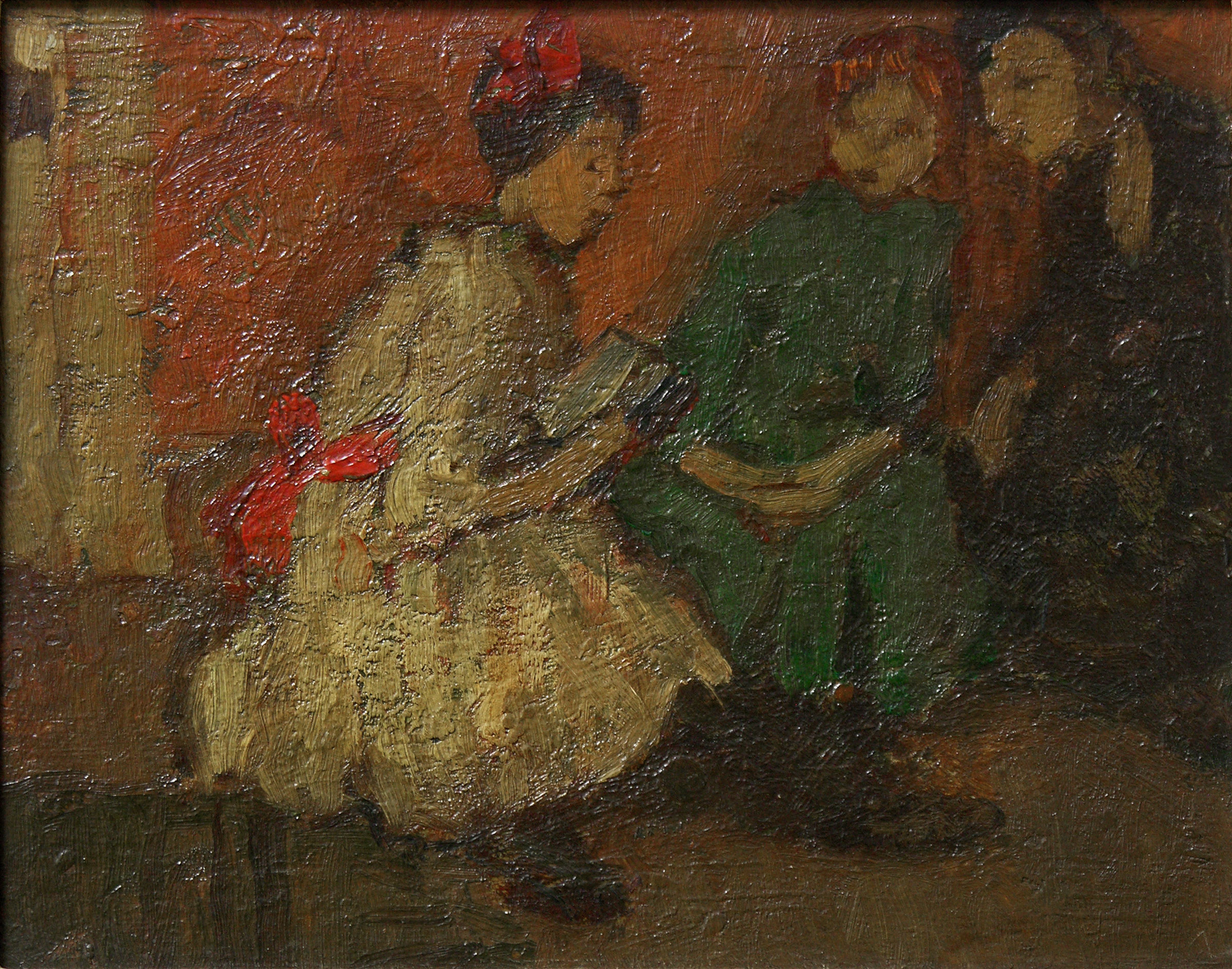Emily Coonan Painting at Klinkhoff Compares with Artist's Best Work

Emily Coonan (1885-1971) Children Reading, ca. 1914 Oil on panel 7 7/8" x 10" Provenance: Private Collection, Montreal.
Emily Coonan’s approach to the figure, particularly as evidenced in her early work, is remarkable for its richly evocative character. Active during the early part of the twentieth century, and embracing a thematic repertoire that included urban views and landscapes as well as figuration, Coonan’s paintings of the WW l era often portrayed the fantasy- filled, fleeting episodes of childhood. Children Reading is a superb example of a series of intimist interiors depicting children immersed in a world apart from ordinary events. Swiftly executed, and devoid of descriptive detail, it testifies to Coonan’s consummate facility as an artist and her skill at conveying the spirit of a scene through spontaneous strokes of paint and the eloquent interplay of chromatic contrasts.
Along with other whimsical works of the epoch, including Visiting a Sick Friend, and The Orphans, it serves as a poignant example of the artist’s unique style and the formal inventiveness by which she captured the lived experiences of children at the beginning of the last century. Coonan’s early oeuvre found focus in the imagery of her immediate world—the domestic entourage of family and friends. In this she shared kinship with other women artists of her generation, including Helen McNicoll and, for a time at least, Mabel May. But the artist’s emphasis on visual design over iconographic referents in the telling of these vignettes renders her work distinctive. Whether depicting a cluster of communicants, ethereal in demeanour and dress, or a single, bobbing file of straw-hatted schoolgirls, the artist ably compels the substance of a moment by pictorial means at once minimal and charged.
Coonan was not an artist of the avant-garde, yet hers was the vocabulary of modernism—at once condensed and compelling—concerned, primarily, with the unfolding of the painting event. Children Reading depicts a trio of young girls clustered together over a storybook. The mood is quiet; the movement is contained. One senses the attentive absorption of the children as a fictive moment unfolds. The stillness of the scene is animated principally by virtue of the textured surface and the dashes and passages of bright and somber hues interacting across a muted dark ground—brilliant red, burnt orange, and the artist’s favourite, deep bottle green. Throughout the teens Coonan’s preferred palette was a decorous one—a blend of dark and dazzling shades that eluded Impressionism’s light- filled, sensory naturalism.
In describing the distinctiveness of her chromatic choices, the Montreal Star’s reviewer observed, “They are all subdued in tone with an occasional gleam of pure colour. It has been said by one recently come from Paris, that her colours ... are too lacking in clearness for the last word in art. On the other hand they are marvelously original.” (1) As always in Coonan’s oeuvre, a degree of artifice informs the painting’s articulation— as seen in the shallow spatial field, the absence of descriptive physiognomies, and the anonymity of the pictured place—reinforcing the notion that the artist’s purpose was neither anecdotal nor narrative, but interested, equally, in the investigation of formal articulacy. Undoubtedly the theme would have had intrinsic appeal for the artist and, like other similar works such as The Duck Pond, Shell Gatherers and The Fairy Tale (Winnipeg Art Gallery), would presumably have attracted her interest by virtue of its inherent ‘charm’. Yet still, Coonan seemingly subordinates sentiment here in favour of the expressive potential of the pictorial design.
The painting’s small scale and schematic immediacy, for instance, act as a visual quotation of the unaffected closeness implied in the imaged scene. Further, while the children are connected to one another by virtue of the centered and centralizing book motif, their placement seems arbitrary, the space they occupy artificial, and they themselves unanchored, echoing our sense of their psychological remove. In this regard at least, these minimally rendered interiors differ from Coonan’s larger figurative works of the same era, including The Green Door (Art Gallery of Hamilton) and Girl with a Rose (National Gallery of Canada) where the bodies themselves are centralized, near-iconic, and anticipate Coonan’s slightly later “house in a landscape” motif.
Coonan was in her late twenties when she painted Children Reading. She was recently embarked on a professional career, and had been the recipient of repeated accolades and awards both during her formal art studies with William Brymner at the School of the Art Association of Montreal. The Pointe-St-Charles “prodigy” had been kept in the public eye by contemporaneous art commentators in The Montreal Star, The Gazette, The Herald and other paper publications for close to a decade, and her works had found favour with numerous art collectors of the local milieu. Certainly her regular participation in the Spring Exhibitions at the AAM, the Royal Canadian Academy shows, Canadian National Exhibitions and other venues showing Canadian art beginning in 1908 served to secure her professional status, as too did her inclusion in such significant showcases as, in 1914, the Exhibition of Pictures Given by Canadian Artists in Aid of the Patriotic Fund.
It was by all accounts a prolific and immensely innovative period within the context of her artistic career. Coonan’s travels abroad in 1912 and 1920, at once inspired new iconographic interests and consolidated her commitment to the exploration of progressive visual vocabularies. Interior settings and peopled environments begin to give way to urban scenes and, later, landscapes which speak to the architectonics of place. City scenes of Paris and Bruges recall the evocative, distilled sensibility of James Wilson Morrice, both in tenor and appearance, and the views of Florence and Venice produced during her second European sojourn reflect the lighter chromatics that would inform her later oeuvre.
Emily Coonan maintained her somewhat uneasy engagement with the public sphere until the early 1930’s. She was briefly associated with Montreal’s Beaver Hall Group, which also included many of Brymner’s former female students including Mabel May, Prudence Heward, Sarah Robertson and Kathleen Morris. Her later images increasingly engaged the figure as a thematic motif, furthering the innovatory formal explorations she had begun in the teens. Enigmatic and evocative, works such Girl in Dotted Dress (Art Gallery of Hamilton) which was exhibited in the British Empire Exhibition in Wembley, England in 1924, demonstrate the virtuosity and vigour of the artist’s unique voice. Mysteriously, Emily Coonan chose to turn away from Montreal’s artistic world at an auspicious moment in her professional career. Her legacy encompasses not only a singularly compelling body of work, but also the significance of her contribution as a Canadian woman artist within the context of the advent of modernism in this country.
Footnotes:
1 Anon., The Montreal Star, March 15, 1912
Copyright Karen Antaki and Galerie Walter Klinkhoff, Montreal, 2011










Add a comment